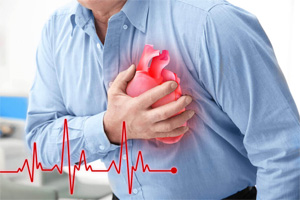- Home
- Editorial
- News
- Practice Guidelines
- Anesthesiology Guidelines
- Cancer Guidelines
- Cardiac Sciences Guidelines
- Critical Care Guidelines
- Dentistry Guidelines
- Dermatology Guidelines
- Diabetes and Endo Guidelines
- Diagnostics Guidelines
- ENT Guidelines
- Featured Practice Guidelines
- Gastroenterology Guidelines
- Geriatrics Guidelines
- Medicine Guidelines
- Nephrology Guidelines
- Neurosciences Guidelines
- Obs and Gynae Guidelines
- Ophthalmology Guidelines
- Orthopaedics Guidelines
- Paediatrics Guidelines
- Psychiatry Guidelines
- Pulmonology Guidelines
- Radiology Guidelines
- Surgery Guidelines
- Urology Guidelines
Low cardiorespiratory fitness increases risk of heart disease

Norway: Low cardiorespiratory fitness (CRF) is strongly associated with the occurrence of coronary heart disease (CHD) even in a healthy and fit person showing no signs of any blood vessel or heart disease, shows a new study.
The study, published in the European Heart Journal finds that VO2peak, the main measure of cardiorespiratory fitness, is strongly and inversely associated with CHD across the whole fitness continuum in a low-risk population sample. Increasing VO2peak may have substantial benefits for reducing CHD burden.
Cardiorespiratory fitness refers to the ability of respiratory and circulatory systems to supply adequate oxygen to skeletal muscles during sustained physical activity. Its main measure is VO2peak - the maximum rate of oxygen consumption during exercise that increases with intensity.
Also Read: Consumption of yogurt, cheese may decrease risk of heart disease
For the purpose, 4527 fit and healthy men and women having no history of cancer or raised blood pressure, cardiovascular or lung disease, had their CRF assessed when they participated in a large population-based health study in Norway (the HUNT3 study) between 2006-2008. They warmed up for ten minutes on a treadmill before running faster and faster, wearing a heart rate monitor and face mask. Their oxygen intake was measured to establish their VO2max.
A strength of the study is that cardiorespiratory fitness was measured with a gold-standard maximal exercise test of peak oxygen uptake (VO2peak) - the first to do this in a healthy sample of the general population. Previous studies that have linked fitness to disease risk in healthy populations are mainly based on self-report or less accurate estimates.
Also Read: Sleeping less than 5 hours doubles risk of Heart disease : ESC Update
Key Findings:
- Average VO2peak was 36.0 mL/kg/min and 44.4 mL/kg/min among women and men, and 83.5% had low 10-year risk of CVD at baseline.
- Average follow-up was 8.8 years, and 147 participants reached the primary endpoint.
- Multi-adjusted Cox-regression showed a 15% lower risk for the primary endpoint per one-MET (metabolic equivalent task) higher VO2peak, with similar results across sex.
- The highest quartile of VO2peak had a 48% lower risk of an event compared with the lowest quartile.
- Oxygen pulse and ventilatory equivalents of oxygen and carbon dioxide also showed significant predictive value for the primary endpoint.
"We found a strong link between greater fitness and reduced risk of a coronary event during the nine years of follow-up in a very healthy sample of adults. In fact, the participants who were in the 25% of those with the highest cardiorespiratory fitness had nearly half the risk compared to those in the 25% with the lowest fitness levels, said Dr. Nes.
"Our results indicate that the greater cardiorespiratory fitness protects against both chronic and acute heart and blood vessel problems," said Dr. Nes. "Even a small increase in fitness could have a large impact on health."
The lead author of the study, Dr. Jon Magne Letnes, who is a medical doctor and research fellow in the Cardiac Exercise Research Group at NTNU, said: "Our results should encourage the use of exercise as preventive medicine. A few months of regular exercise may be an efficient way of reducing cardiovascular risk."
"This study adds to the current literature by demonstrating a similar benefit in an ostensibly healthy population with an incremental benefit that continues beyond 12 METS and suggests that there is no obvious upper threshold for the cardioprotective effects of exercise. Although the number of subjects is laudable, there are several points to note." Professor Sanjay Sharma and Dr. Aneil Malhotra, of St George's University of London (UK), and write in an accompanying editorial
"In an era where primary prevention is playing an increasingly significant role in society, this study helps to highlight that improving CRF is a pivotal factor in reducing CV [cardiovascular] risk and mortality. Regular physical activity and measures of CRF should be incorporated into clinical practice and CV risk models. All individuals should be encouraged to exercise to the minimal level recommended by the European guidelines for disease prevention, although the observations of Letnes and colleagues and several others suggest that substantially higher physical activity levels and CRF provide additional prognostic benefit. For those who are compromised due to comorbidities or functional status, there is overwhelming evidence that some physical activity is better than none," they conclude.
For further reference follow the link: https://doi.org/10.1093/eurheartj/ehy708

Disclaimer: This site is primarily intended for healthcare professionals. Any content/information on this website does not replace the advice of medical and/or health professionals and should not be construed as medical/diagnostic advice/endorsement or prescription. Use of this site is subject to our terms of use, privacy policy, advertisement policy. © 2020 Minerva Medical Treatment Pvt Ltd